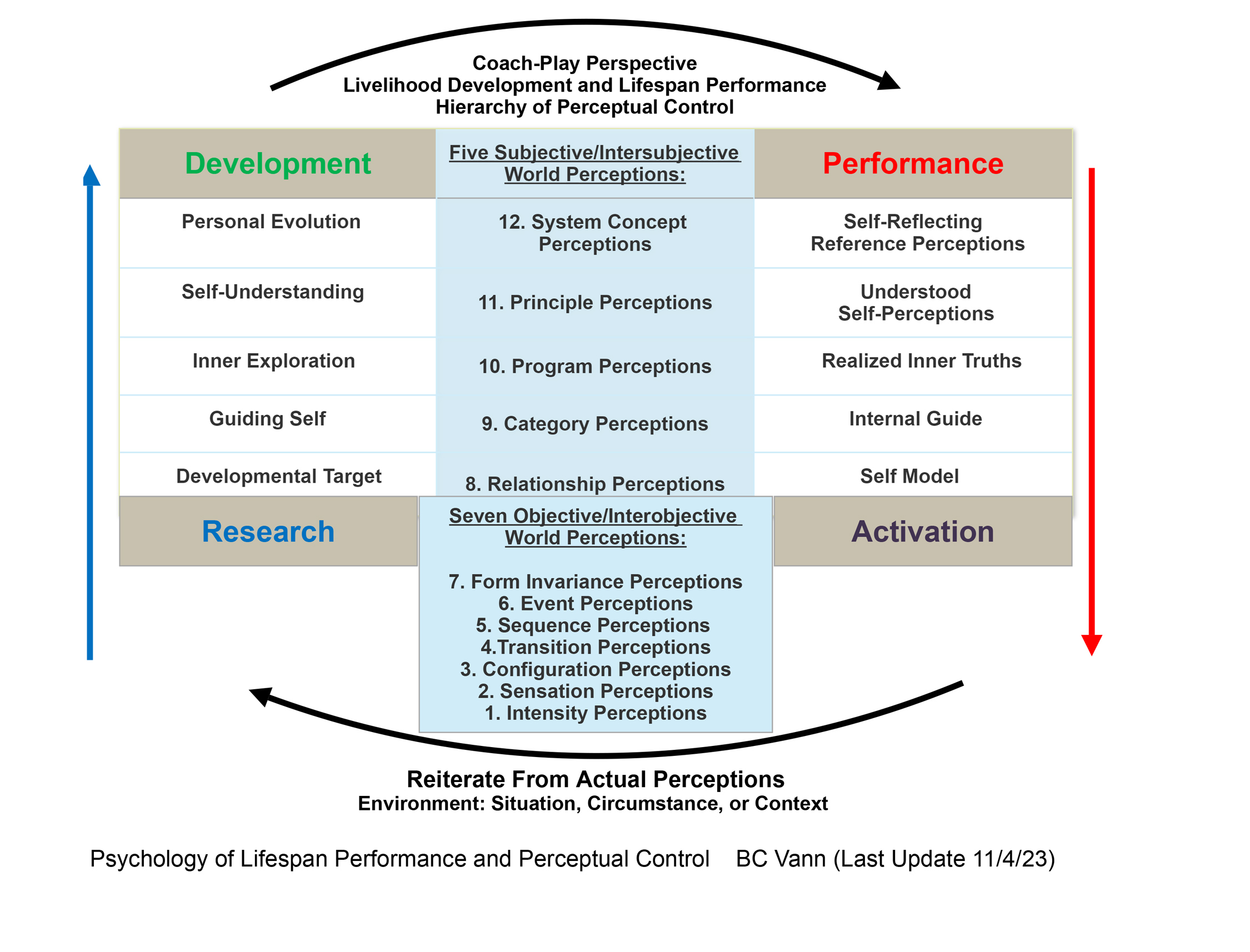As Your Resource For Self-Development
- The Optima Bowling Coach (2025)
A Systems-of-Systems Perspective
(Page Update 5/15/25)
Every perceptual act, every muscular adjustment, every conceptual leap takes place inside a lattice of feedback loops larger than itself. Optima Bowling identifies this lattice as a system-of-systems: a constellation of semi-autonomous subsystems whose reciprocal constraints generate realities that no isolated part could predict. That concept was earlier mapped in broad strokes, aligning it with Perceptual Control Theory and the Potentiality–Actuality flow. Here, the upgraded page refines both scope and intent. It positions the system-of-systems lens as the indispensable grammar through which the site’s seven navigation tiers (Data, Information, Knowledge, Competence, Comprehension, Context, and Claim) translate scattered perceptions into lived coherence.
Clarify
The "Back to the Beginning” pages supply autobiographical data points: episodes where uncontrolled perceptions signaled systemic misalignment. In isolation, those vignettes resemble anecdotes; within an SoS frame, they reveal how an individual’s sensory snapshots already embed social, ecological, and historical circuitry. The bowler’s first reactive flinch before release is not merely neuromuscular noise; it is a node where family expectations, material culture, and personal myth converge. Clarifying this nested backdrop advances the reader from noticing data to recognizing patterns, the indispensable shift that turns raw experience into Information.

Contrast
The “How to Control Your Life” pages deepen the discourse by detailing Lifespan Performance and Perceptual Control. Here, single-loop feedback diagrams contrast with the SoS web. A reference value (i.e., desired ball rotation) meets perceptual input and yields corrective output. The SoS lens complicates that elegance: a loop succeeds or fails in proportion to the fidelity of loops enveloping it. A perfectly aligned thumb exit cannot override institutional incentives that reward risk-prone spectacle, nor can a pristine practice regimen substitute for a family rhythm that deprioritizes rest. The contrast is instructive: local control introduces agency; systemic control guards that agency from collateral distortion.
Integrate
The PIE: Coach-Play Perspective in Motion recasts coach and player as coupled regulators co-editing the same perception field. Purpose sets the reference, Integrity governs alignment, Experience supplies real-time data. Within an SoS architecture, the triad functions as an integrative hinge: Purpose selects which subsystem merits foreground attention, Integrity distributes tension across the hierarchy, and Experience feeds continuous state updates back up the stack. Integration here means choreography—each role adjusting until mutual resonance emerges and surplus friction dissipates.
Substantiate
The four accumulative phases of Performance Authentication (Management, Development, Versatility, and Optimization) through which skills progress into self-authorizing excellence. The SoS vocabulary substantiates why the phases must be sequential. Management attends to discrete variables; Development coordinates clusters; Versatility toggles between clusters under shifting conditions; Optimization relinquishes micromanagement in favor of meta-level harmony. Each transition demands more effort and heightened sensitivity to feedback emanating from broader systemic rings. Subsystems that refuse to graduate on schedule impede the flow, producing stagnation that training volume alone cannot dissolve.
Illuminate
Optima Bowling’s Three Levels of Being Human (Physical-Etheric, Emotional Attractive-Repulsive, and Mental-Causal) map the interior topography that mirrors exterior complexity. Illumination arises when the reader perceives that each ontological stratum runs its independent yet interlocking regulation loops. Physical fatigue modulates emotional tolerance; emotional turbulence biases cognitive framing; causal vision retroactively re-weights bodily micro-choices. The SoS lens neither collapses the layers into a homogenous “mind-body” blur nor elevates one as sovereign; it illuminates the mutual entailment that must be respected if any authentic performance activation is to endure.
Historical momentum supplies the next lens. Past-Stream wisdom, Mainstream methodology, and Future-Stream speculation comprise a triadic current feeding the present scope. By tracing how earlier craft traditions, contemporary analytics, and emergent neuro-technological insights interlock into present practice, the SoS perspective dispels the myth of isolated innovation. Every “new” drill inherits assumptions from forgotten guilds; every analytics dashboard embeds values that will later be judged quaint. Understanding this ideological hybridization inoculates the practitioner against fads while sustaining adaptive curiosity.
Invite
Fragmentation and Wholeness appear, at first glance, as rivals. In truth, they denote alternating emphasis within the same systemic choreography. Fragmentation focuses on precision; wholeness restores context. Optima Bowling invites the reader to rotate attention rhythmically between the two poles: isolate a loop long enough to stabilize it, then zoom out until its systemic obligations come into view. The invitation resists motivational platitudes; it offers a reflective practice: track where control wavers, ask which adjacent subsystem might be broadcasting contradictory reference values, and adjust alignment rather than intensity.
Practical Bearings
Educational institutions translate the SoS ethos into curriculum design that spirals from concrete manipulation to abstract modeling, mirroring the navigation tiers of the website. Coaching enterprises adopt diagnostics that profile nested feedback loops instead of singling out personality “types.” The self-help sector re-evaluates quick-fix models, substituting protocols that teach systemic discernment: identify the scale at which intervention will yield the least unintended turbulence.
- Education refines pedagogy into recursive modules that honor cognitive load at one tier while gesturing toward integration at the next.
- Coaching calibrates feedback cadence so athlete, team, and organizational loops stay phase-aligned.
- Personal Development repurposes reflective journaling into a sensor suite, capturing perturbations across physical, emotional, and causal registers.
Synthesis
Data without systems literacy elicits fascination but not change; Information without nesting retains predictability but forfeits depth; Knowledge without multi-scale competence breeds overconfidence; Competence devoid of comprehension solves yesterday’s puzzle; Context without a master Claim risks rhetorical drift. The SoS perspective threads these tiers into a single architectural sweep. By reading, practicing, and internalizing that architecture, the learner rehearses the skill that the 21st-century demands: steering nested feedback loops without collapsing into reductionism or drowning in complexity.
Optima Bowling, therefore, asserts that a viable future—athletic, educational, or planetary—hinges on persons who think, feel, and act systemically. The System-of-Systems perspective is not an elective metaphor; it is the structural beam on which every subsequent narrative load must rest.
See More: A Systemic Look at Our World